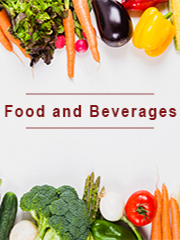Report overview
Kosher foods are those that conform to the Jewish dietary regulations of kashrut (dietary law), primarily derived from Leviticus and Deuteronomy. Food that may be consumed according to halakha(law) is termed kosher in English. Food that is not in accordance with law is called treif from Hebrew meaning "torn".
This report aims to provide a comprehensive presentation of the global market for Kosher Foods, with both quantitative and qualitative analysis, to help readers develop business/growth strategies, assess the market competitive situation, analyze their position in the current marketplace, and make informed business decisions regarding Kosher Foods. This report contains market size and forecasts of Kosher Foods in global, including the following market information:
Global Kosher Foods Market Revenue, 2018-2023, 2024-2029, ($ millions)
Global Kosher Foods Market Sales, 2018-2023, 2024-2029, (K MT)
Global top five Kosher Foods companies in 2022 (%)
The global Kosher Foods market was valued at US$ 9832.9 million in 2022 and is projected to reach US$ 17750 million by 2029, at a CAGR of 8.8% during the forecast period. The influence of COVID-19 and the Russia-Ukraine War were considered while estimating market sizes.
The classical rabbinical writers imply that milk from an animal whose meat is kosher is also kosher. As animals are considered non-kosher if after being slaughtered they are discovered to have been diseased; this could make their milk retroactively non-kosher. However, by adhering to the principle that the majority case overrules the exception, Jewish tradition continues to regard such milk as kosher, since statistically it is true that most animals producing such milk are kosher; the same principle is not applied to the possibility of consuming meat from an animal which has not been checked for disease.
We surveyed the Kosher Foods manufacturers, suppliers, distributors and industry experts on this industry, involving the sales, revenue, demand, price change, product type, recent development and plan, industry trends, drivers, challenges, obstacles, and potential risks.
Total Market by Segment:
Global Kosher Foods Market, by Type, 2018-2023, 2024-2029 ($ Millions) & (K MT)
Global Kosher Foods Market Segment Percentages, by Type, 2022 (%)
Kosher Pareve
Kosher Meat
Kosher Dairy
Global Kosher Foods Market, by Application, 2018-2023, 2024-2029 ($ Millions) & (K MT)
Global Kosher Foods Market Segment Percentages, by Application, 2022 (%)
Supermarkets
Restaurants
Food and Beverage Industry
Global Kosher Foods Market, By Region and Country, 2018-2023, 2024-2029 ($ Millions) & (K MT)
Global Kosher Foods Market Segment Percentages, By Region and Country, 2022 (%)
North America
US
Canada
Mexico
Europe
Germany
France
U.K.
Italy
Russia
Nordic Countries
Benelux
Rest of Europe
Asia
China
Japan
South Korea
Southeast Asia
India
Rest of Asia
South America
Brazil
Argentina
Rest of South America
Middle East & Africa
Turkey
Israel
Saudi Arabia
UAE
Rest of Middle East & Africa
Competitor Analysis
The report also provides analysis of leading market participants including:
Key companies Kosher Foods revenues in global market, 2018-2023 (Estimated), ($ millions)
Key companies Kosher Foods revenues share in global market, 2022 (%)
Key companies Kosher Foods sales in global market, 2018-2023 (Estimated), (K MT)
Key companies Kosher Foods sales share in global market, 2022 (%)
Further, the report presents profiles of competitors in the market, key players include:
ADM
Kedem Food Products
Manischewitz
Nestl?
Streit's
Art Chocolatier
BASF
Blommer Chocolate
Brooklyn Cookie
Denovo Beverage
Eden Foods
Hodo Soy
Ice Chips
Levana Meal Replacement
Outline of Major Chapters:
Chapter 1: Introduces the definition of Kosher Foods, market overview.
Chapter 2: Global Kosher Foods market size in revenue and volume.
Chapter 3: Detailed analysis of Kosher Foods manufacturers competitive landscape, price, sales and revenue market share, latest development plan, merger, and acquisition information, etc.
Chapter 4: Provides the analysis of various market segments by type, covering the market size and development potential of each market segment, to help readers find the blue ocean market in different market segments.
Chapter 5: Provides the analysis of various market segments by application, covering the market size and development potential of each market segment, to help readers find the blue ocean market in different downstream markets.
Chapter 6: Sales of Kosher Foods in regional level and country level. It provides a quantitative analysis of the market size and development potential of each region and its main countries and introduces the market development, future development prospects, market space of each country in the world.
Chapter 7: Provides profiles of key players, introducing the basic situation of the main companies in the market in detail, including product sales, revenue, price, gross margin, product introduction, recent development, etc.
Chapter 8: Global Kosher Foods capacity by region & country.
Chapter 9: Introduces the market dynamics, latest developments of the market, the driving factors and restrictive factors of the market, the challenges and risks faced by manufacturers in the industry, and the analysis of relevant policies in the industry.
Chapter 10: Analysis of industrial chain, including the upstream and downstream of the industry.
Chapter 11: The main points and conclusions of the report.
